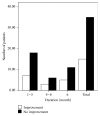Recovery of Olfactory Function in Postviral Olfactory Dysfunction Patients after Acupuncture Treatment
- PMID: 27034689
- PMCID: PMC4789421
- DOI: 10.1155/2016/4986034
Recovery of Olfactory Function in Postviral Olfactory Dysfunction Patients after Acupuncture Treatment
Abstract
Introduction. The aims of this study were to assess the impact of traditional Chinese acupuncture (TCA) in postviral olfactory dysfunction (PVOD) patients who were refractory to standardized treatment and to compare the results with the impact observed in an observation group. Methods. Fifty patients who presented to the outpatient clinic with PVOD and were refractory to standardized treatment were included: 25 were treated with TCA and 25 patients were simply observed. A subjective olfactory test was performed using the University of Pennsylvania Smell Identification Test (UPSIT). The effects of TCA were compared with the results obtained in the observation group. Results. Improved olfactory function was observed in eleven patients treated with TCA compared with four patients in the observation group. This study revealed significantly improved olfactory function outcomes in patients who underwent acupuncture compared with the observation group. No significant differences in olfaction recovery were found according to age, gender, or duration of disease between the two groups; however, hyposmic patients recovered at a higher rate than anosmic patients. Conclusion. TCA may aid the treatment of PVOD patients who are refractory to drugs or other therapies.
Figures






Similar articles
-
Effects of traditional Chinese acupuncture in post-viral olfactory dysfunction.Otolaryngol Head Neck Surg. 2010 Apr;142(4):505-9. doi: 10.1016/j.otohns.2010.01.012. Otolaryngol Head Neck Surg. 2010. PMID: 20304268
-
Therapeutic Potential of Valproic Acid for Postviral Olfactory Dysfunction: A Single-Arm Pilot Study.Ann Otol Rhinol Laryngol. 2023 Jun;132(6):709-714. doi: 10.1177/00034894221111245. Epub 2022 Jul 13. Ann Otol Rhinol Laryngol. 2023. PMID: 35833237 Clinical Trial.
-
Olfactory dysfunction from acute upper respiratory infections: relationship to season of onset.Int Forum Allergy Rhinol. 2020 Jun;10(6):706-712. doi: 10.1002/alr.22551. Epub 2020 Apr 13. Int Forum Allergy Rhinol. 2020. PMID: 32282136 Free PMC article.
-
Is SARS-CoV-2 (COVID-19) postviral olfactory dysfunction (PVOD) different from other PVOD?World J Otorhinolaryngol Head Neck Surg. 2020 Nov;6(Suppl 1):S26-S32. doi: 10.1016/j.wjorl.2020.05.004. Epub 2020 May 19. World J Otorhinolaryngol Head Neck Surg. 2020. PMID: 32837756 Free PMC article. Review.
-
Steroids and Olfactory Training for Postviral Olfactory Dysfunction: A Systematic Review.Front Neurosci. 2021 Aug 12;15:708510. doi: 10.3389/fnins.2021.708510. eCollection 2021. Front Neurosci. 2021. PMID: 34456675 Free PMC article.
Cited by
-
Waking Up and Literally Smelling the Coffee: Inducing Olfactory Function with 3-Phase Auricular Therapy.Med Acupunct. 2019 Feb 1;31(1):45-48. doi: 10.1089/acu.2018.1326. Epub 2019 Feb 7. Med Acupunct. 2019. PMID: 30805079 Free PMC article.
-
Post-traumatic olfactory dysfunction: a scoping review of assessment and rehabilitation approaches.Front Neurol. 2023 Jul 13;14:1193406. doi: 10.3389/fneur.2023.1193406. eCollection 2023. Front Neurol. 2023. PMID: 37521284 Free PMC article.
-
Interventions for the prevention of persistent post-COVID-19 olfactory dysfunction.Cochrane Database Syst Rev. 2022 Sep 5;9(9):CD013877. doi: 10.1002/14651858.CD013877.pub3. Cochrane Database Syst Rev. 2022. PMID: 36063364 Free PMC article.
-
Frequency and outcome of olfactory impairment and sinonasal involvement in hospitalized patients with COVID-19.Neurol Sci. 2020 Sep;41(9):2331-2338. doi: 10.1007/s10072-020-04590-4. Epub 2020 Jul 12. Neurol Sci. 2020. PMID: 32656713 Free PMC article.
-
The Effect of Traditional Chinese Medicine on Postviral Olfactory Dysfunction: A Systematic Review and Meta-Analysis.Evid Based Complement Alternat Med. 2023 Jan 18;2023:7448034. doi: 10.1155/2023/7448034. eCollection 2023. Evid Based Complement Alternat Med. 2023. PMID: 36714533 Free PMC article. Review.
References
-
- Fornazieri M. A., Dos Santos C. A., Bezerra T. F. P., De Rezende Pinna F., Voegels R. L., Doty R. L. Development of normative data for the Brazilian adaptation of the university of pennsylvania smell identification test. Chemical Senses. 2015;40(2):141–149. doi: 10.1093/chemse/bju068. - DOI - PubMed
LinkOut - more resources
Full Text Sources
Other Literature Sources
Medical

